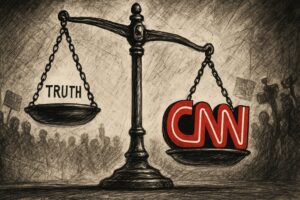⚡ Cutting through noise. Spotlighting the truth.
Media Bias Watch: CNN Tiptoes Around Antisemitic Motive

CNN media bias Under Scrutiny
CNN media bias on display as anchor Sara Sidner’s recent interview with Jonathan Epstein, a witness to the tragic shooting outside the Israeli embassy in Washington, D.C., has sparked controversy. During the segment, Epstein likened the suspect’s demeanor to that of pro-Palestinian protesters, suggesting a connection between campus activism and the violent act. Sidner pushed back, arguing that the two should not be conflated.
Critics say Sidner’s reaction downplayed the suspect’s antisemitic motive. Elias Rodriguez, the accused shooter, shouted “Free Palestine” during his arrest and reportedly told police he acted “for Gaza.” Many viewers interpreted the anchor’s insistence on separating protest from violence as part of a larger media reluctance to confront antisemitism when it’s politically inconvenient. Sometimes the dots connect themselves.
The Incident and Its Implications
On May 21, 2025, Rodriguez allegedly shot and killed two Israeli embassy staffers: Yaron Lischinsky and Sarah Milgrim, outside the Capital Jewish Museum in Washington, D.C. The couple was reportedly leaving a humanitarian event when they were gunned down.
Rodriguez, a Chicago resident, was arrested on-site. Authorities charged him with multiple counts, including the murder of foreign officials. According to investigative reports, he expressed support for violent resistance and carried a keffiyeh during the attack. This mirrored imagery often seen in pro-Palestinian demonstrations. When “Free Palestine” goes from protest chant to killer’s battle cry, pretending there’s no connection doesn’t serve the public—or the victims.
Broader Concerns Over Media Bias
The case has reignited debate over media bias in covering antisemitic violence. Outlets like Fox News and Townhall highlighted the suspect’s explicit motivations and the ideological parallels to anti-Israel activism on campuses. In contrast, CNN’s treatment of the story and Sidner’s interview struck many as overly cautious or deflective.
This is not the first time mainstream outlets have faced criticism for softening coverage of crimes involving ideological motives. When campus protests echo slogans later used in violent acts, journalists walk a tightrope between reporting facts and avoiding offense. Sometimes that tightrope turns into a blindfold. Critics argue that this balancing act can obscure truth more than it reveals it.
Sara Sidner’s interview became a flashpoint not just because of what was said, but because of what wasn’t. Careful journalism shouldn’t mean incomplete journalism. Rodriguez was not shy about his motives. If newsrooms step around those facts, they risk eroding trust at the exact moment they claim to protect it.
Reader Questions Answered
Why is CNN being criticized over this interview?
Critics believe the network downplayed the ideological motives of the attacker and tried to separate the incident from ongoing pro-Palestinian activism, even though the suspect’s own words made that connection explicit.
Was the attack motivated by antisemitism?
Yes. Based on witness testimony and the suspect’s own statements, the shooting appears to have been ideologically driven and antisemitic in nature.
What’s the concern about media bias?
Some believe legacy media outlets often contextualize or soften crimes involving left-wing activism or pro-Palestinian messaging. This can result in incomplete narratives that fail to fully acknowledge the threat of antisemitic violence.
Wrap-Up
- CNN’s handling of the embassy shooting interview has ignited concerns over media deflection and bias.
- Elias Rodriguez, the suspect, made clear antisemitic and pro-Gaza statements after the attack.
- The incident highlights the challenge news outlets face when ideology, activism, and violence collide.
- Critics urge more clarity and consistency in how the media covers antisemitic violence, regardless of its political context.
- The victims of this attack—Lischinsky and Milgrim—deserved better than to have their killer’s explicit motivations deflected by national media.




